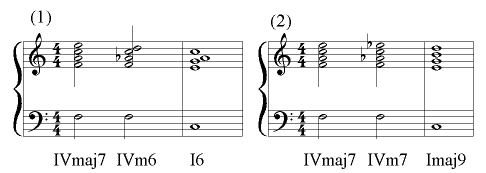Using Modal Interchange to Alter Chords
Modal interchange is a system that helps us to create interesting and musically relevant chord alterations. This is another type of chromatic chords, which means that one or more note is not in the actual key signature or implied key center.
We have already discussed two types of chromatic chord
- Secondary dominants – which are often used in jazz to create chromatic interest.
- We have also seen how upper extensions can be altered:

Jazz musicians often reharmonise standard tunes not only by altering chords but by using substitute chords. When an established melody is being played the choice of these new chords is restricted by the melody note, however during improvised solos there is far more freedom.
As mentioned earlier – see Minor Harmony – chords can be borrowed from other modes. This is sometimes called modal interchange and is common between a major key and its parallel minor. (not the relative minor which has the same key signature, but the minor key which has the same tonic). Chords can be borrowed from the harmonic minor, melodic minor or any minor mode. Here are some of the more common examples:
1) Substitutions for V7.
bVII7 can be substituted for V7. This is borrowed from the Aeolian mode of C (based on major scale of Eb – Cm7, Dø7, Ebma7, Fm7, Gm7, Abma7, Bb7, Cm7), but used in a major key.

IVm7 (or IVm6) can also be substituted for V7. Also borrowed from the Aeolian mode (Cm7, Dø7, Ebma7, Fm7, Gm7, Abma7, Bb7, Cm7)

Combine these two and we have a II-V progression borrowed from the Aeolian mode

From the above we can see that a IIm7-V7 in an apparently unrelated key (i.e. IIm7-V7 in Eb can be used in the dominant area of the key of C (see Misty bar 4).
bVII maj7 (from the Dorian) can also be used in modal interchange but does not lend itself to the IIm7-V7 progression in ex 7c, and is not such a good substitute where a perfect cadence is implied.
2) Substitutes for IVmaj7
By borrowing from the Aeolian mode again, IV maj7 (or 6) can be altered to IV m maj7 (or 6) or IV m7. In popular music of the 30’s, 40’s and 50’s IVm was often used following a IV and preceding a I, adding passing notes to a plagal (IV-I) cadence.
